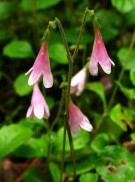 A native of cool moist woods, twinflower often grows into large mats forming a beautiful ground cover. Bright green, glossy, evergreen leaves are borne in pairs on slender woody stems that may extend three feet in length. Delicate pink to white nodding flowers are fragrant and last about a week. They are produced in pairs on slender stalks in summer giving the plant its common name. The generic name refers to Carl Linnaeus a botanist known as the father of taxonomy. He chose twinflower as his personal emblem and had his portrait painted holding a twinflower plant.
A native of cool moist woods, twinflower often grows into large mats forming a beautiful ground cover. Bright green, glossy, evergreen leaves are borne in pairs on slender woody stems that may extend three feet in length. Delicate pink to white nodding flowers are fragrant and last about a week. They are produced in pairs on slender stalks in summer giving the plant its common name. The generic name refers to Carl Linnaeus a botanist known as the father of taxonomy. He chose twinflower as his personal emblem and had his portrait painted holding a twinflower plant.
Type: Herbaceous perennial
Bloom: Two white to pink flowers are produced on a slender stalk in late spring to summer.
Foliage: Broadly elliptic to almost round leaves are opposite, shiny, and evergreen.
Size: 4-6” H x 36” W
Light: Shade, part shade, part sun, sun (if moisture abundant)
Soil: Humus–rich, moist, well-drained,acidic (pH
Hardiness: Zones 2-6
Care: Low maintenance
Pests and Diseases: None of significance
Propagation: Stem cuttings in summer; layering; seed in late fall or early spring (difficult to collect and slow to germinate)
Companion plants: Sword fern (Polystichum munitum), western trillium (Trillium ovatum); native azaleas.
